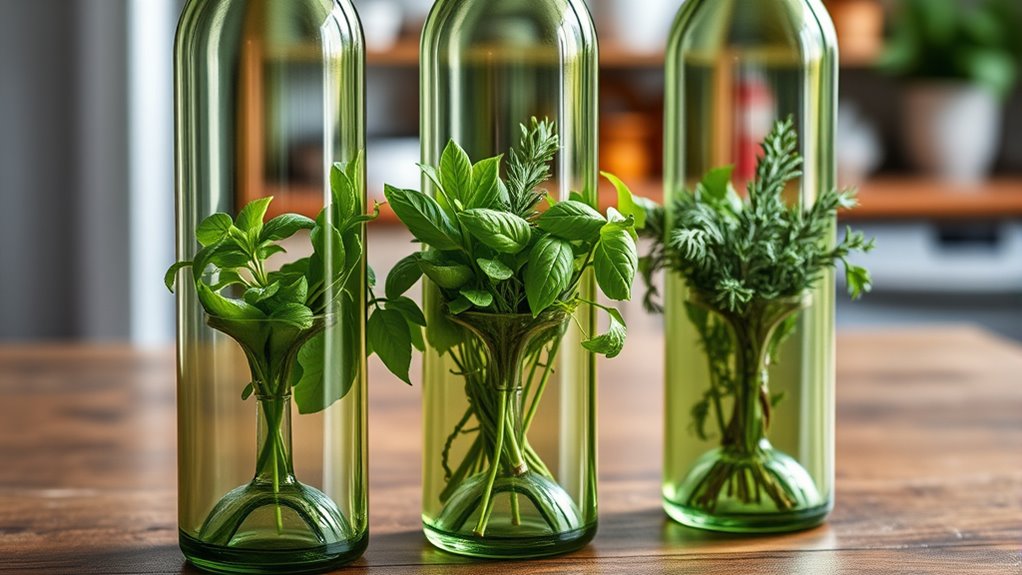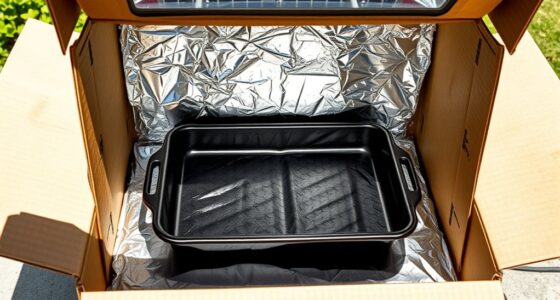To upcycle wine bottles into indoor herb planters, start by choosing your favorite bottles and cleaning them thoroughly. Use a glass cutter or bottle-cutting kit to carefully create an opening, then smooth the edges with sandpaper. Fill the bottles with potting soil and plant herbs like basil or mint. Arrange or hang them in a sunny spot to enjoy fresh herbs and add a creative eco-friendly touch to your home. Keep exploring to discover more tips and ideas.
Key Takeaways
- Select suitable wine bottles, clean thoroughly, and carefully cut the top to create an opening for planting.
- Fill the bottle with potting soil, add herbs like basil or mint, and ensure proper drainage with stones or holes.
- Smooth sharp edges with sandpaper or a file to prevent injuries during handling and planting.
- Place the herb planters near sunlight-rich windows and water regularly for healthy herb growth.
- Hang or display the bottles creatively to add an eco-friendly, decorative touch to indoor spaces.

Upcycling wine bottles is a simple way to turn discarded glass into beautiful, functional decor or useful items. Instead of tossing those empty bottles into the trash, you can transform them into charming indoor herb planters that add freshness and personality to your living space. This approach aligns with glass recycling efforts, reducing waste and promoting sustainable decor. By repurposing bottles, you cut down on the need for new materials and give your home a unique, eco-friendly touch.
Transform discarded bottles into charming, eco-friendly decor and functional herb planters for a sustainable home touch.
To start, choose your wine bottles carefully. Clear glass works best for a bright, airy look, but colored bottles can add a splash of color to your decor. Clean the bottles thoroughly, removing labels and glue, so your final product looks polished. You’ll want to cut the bottles, which can seem intimidating, but with the right tools—like a glass cutter or a specialized bottle-cutting kit—you can do it safely and smoothly. Filling the bottles with water and rotating them slowly helps prevent cracking while you make your cut. Once you’ve cut the bottles into your desired height, smooth the edges with sandpaper or a file to avoid any sharp points.
Next, choose your herbs. Basil, mint, parsley, and cilantro are popular choices for indoor gardening. Fill the cut bottles with potting soil, leaving enough space for your herbs’ roots. Make sure to add drainage holes at the bottom of each bottle—drill carefully or use small stones at the bottom to prevent waterlogging. Place your herb planters near windows with plenty of sunlight, and water them regularly to keep your herbs thriving. Proper light conditions are essential for healthy growth, especially indoors where sunlight may be limited. This small garden not only provides fresh ingredients for cooking but also creates a lovely visual impact in your home.
Using wine bottles as herb planters is more than just a creative project; it’s a statement about sustainable decor. By upcycling glass bottles, you participate in glass recycling, which helps reduce landfill waste and conserves natural resources. These planters can be hung or placed on shelves, adding a rustic or modern look depending on your style. They’re inexpensive, customizable, and eco-conscious, making them a perfect addition to any indoor space. Plus, caring for your herbs in these repurposed bottles makes you more aware of sustainable living, turning waste into beauty and functionality.
Incorporating upcycled wine bottles into your home decor proves that sustainability can be stylish and practical. It’s a simple act that supports glass recycling and showcases your creativity. Whether you’re a seasoned green thumb or just starting, these indoor herb planters are a rewarding way to bring nature inside while making eco-friendly choices.
Frequently Asked Questions
What Types of Herbs Are Best for Wine Bottle Planters?
You should choose herbs that thrive in small, well-draining containers for your wine bottle planters. Basil, mint, parsley, chives, and cilantro are excellent options due to their herb compatibility and ease of growth. When decorating your bottles, consider the herb’s height and color to enhance the bottle’s appearance. These herbs not only grow well in bottles but also add fresh flavor to your meals, making your bottle decoration both functional and attractive.
How Do I Prevent Mold Inside the Upcycled Wine Bottles?
You’ll want to stop mold from taking over your wine bottle herb garden faster than a forest fire! To prevent mold, make certain proper drainage by drilling holes at the bottom and avoid overwatering. Use well-draining soil, and don’t forget to wipe down the inside regularly. These drainage tips allow excess water to escape, preventing mold buildup and keeping your herbs healthy and thriving!
Can I Use Colored or Decorated Wine Bottles for Planting?
Yes, you can use decorative bottle choices and plant in colored bottles. Just make certain the bottles have proper drainage holes, which might mean drilling into the glass. Keep in mind that colored bottles can affect sunlight exposure, so select plants suited for lower light if needed. Decorative and colored bottles add visual interest, but monitor moisture levels to prevent mold and ensure your herbs thrive.
What Soil Type Is Ideal for Herbs in Glass Bottles?
Think of your herbs as little dancers needing the perfect stage. Use a well-draining soil mix that prevents water from pooling, like a gentle stream guiding their roots. Opt for a light, airy blend rich in nutrients to meet their requirements and keep them thriving. This guarantees your glass bottle garden stays lively, with roots happy and healthy, ready to produce fragrant, fresh herbs every time you pass by.
How Often Should I Water Herbs in These Planters?
You should water your herbs in glass bottle planters when the top inch of soil feels dry, typically every 2-3 days. Keep an eye on humidity control; if the air is very dry, you might need to water a bit more often. Make certain of proper drainage and avoid overwatering to prevent root rot. Adjust your watering frequency based on plant needs and environmental conditions for healthy, thriving herbs.
Conclusion
By transforming wine bottles into herb planters, you’re not just repurposing; you’re planting the seeds of sustainability and creativity. Each bottle, like a new chapter, symbolizes growth and renewal, turning everyday objects into symbols of life and nourishment. As your herbs flourish, so does your connection to the environment, reminding you that even the simplest acts can cultivate a more vibrant, eco-friendly future. Embrace this art of upcycling, and watch your space—and your impact—grow.








